
The Ocean and Climate
The transportation of energy from the sun
-
Most of our energy on Earth comes from the sun; the sun’s radiation heats up our planet, and through this drives the winds and waves.
- Photosynthesis harnesses the sun’s energy and converts it into food, and photocells convert sunlight into useful electrical energy.
- The Earth is surrounded by water and gas; both act like fluids.
- Temperatures set up currents in the oceans and the atmosphere, which spread the heating effect of the sun around the planet; just like a radiator spreads heat around a house.
- Currents in the sea and air take energy from the tropics to the colder regions of the Earth.
- In the North Atlantic region, the winds (containing water vapour) travel from the south west to the north east; this warms up Northern Europe; in winter, as much as 25% of our energy is supplied in this way.
- Water also travels from south west to north east in the Atlantic; this makes up the North Atlantic drift; a vast “conveyor belt” of water that keeps Northern Europe warm.
- Surface currents are driven by the prevailing winds and they alter course as they are deflected by large land masses:
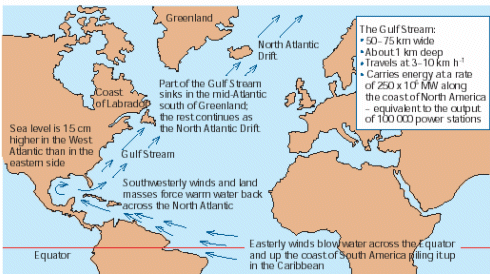
- The specific heat capacity is a measure of how good a substance is at storing energy; it is the amount of energy that has to be put into 1g of a substance by 1 K.
- It can therefore tell us how much energy can be taken out of a substance before it cools down by 1 K.
- The specific heat energy of water is very high compared to that of other substances:
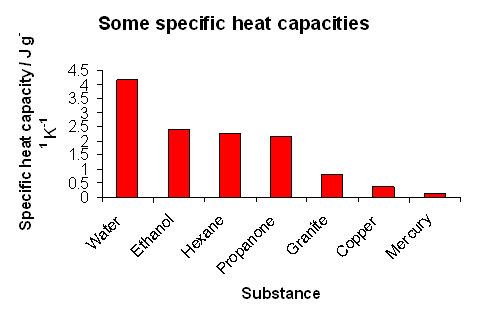
- From the graph, it is evident that water is the best liquid for transporting energy.
- On its way across the North Atlantic, the Gulf Stream meets two currents of cold water; one runs down the eastern coast of Greenland and the other flows down the north east coast of Canada.
- The currents are fed by the melting ice and snow from the Greenland ice-sheet, and so their salinity is low; the Gulf Stream has a relatively high salinity (warm water evaporates leaving behind the salt).
- Above 4oC, the colder the water is, the denser it is; water with a high salinity is also denser than that with a low salinity.
- When the salty warm water in the Gulf Stream meets the cold water currents, it becomes much colder.
- The cold currents also become saltier; the result of this is that a large body of water sinks.
- The landmass of Greenland deflects the sinking water to the south; this creates a conveyor belt system; a deep water cold current flows along the same route as the Gulf stream, but in the opposite direction:
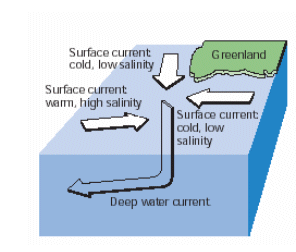
- Another deep water current is generated in the Antarctic; the two deep water currents meet in the South Atlantic, where the geography of the Earth and its rotation cause them to flow eastwards.
- The water slowly rises back to the surface in the Indian and Pacific Oceans; it eventually returns to the surface to replenish the Atlantic.
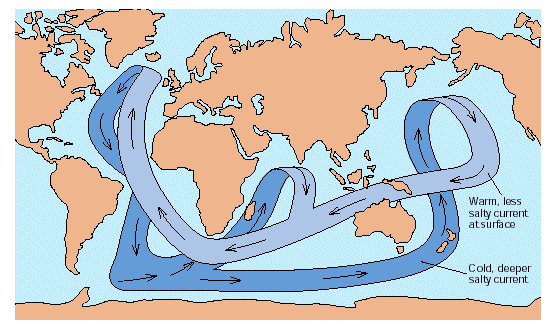
- The huge conveyor belts carry energy and materials around the planet; it can take thousands of years for water which has sunk to resurface.
- There are worries that climate changes will eventually disrupt the conveyor belt of water; for example, increasing temperatures may result in more of the ice-sheets melting; this will flush the Gulf Stream with pure water. This may prevent the water from sinking. This would make Europe much colder.
Evaporation of water
- In addition to just spreading the energy in ocean currents, evaporation and condensation also spread energy.
- When water evaporates, energy is used to separate the molecules that are held together by hydrogen bonding; this energy is known as the enthalpy of evaporation,
 Hevap.
Hevap.
- When the water vapour then condenses again, the intermolecular forces are being reformed and therefore energy is given out; condensation is an exothermic process and the energy change is -
 Hevap.
Hevap.
- Therefore, the tropics are cooled by evaporation; the water vapour is then carried to the colder, high altitude regions where it cools to release the energy:
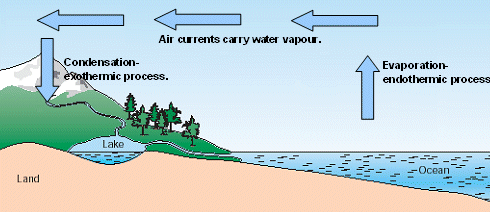
- Water has a very high enthalpy of evaporation compared to other substances:

- This is related to the extra energy that is required to break the stronger intermolecular forces in water; hydrogen bonding.
- This makes water a useful substance for carrying energy.
Useful books for revision
Revise A2 Chemistry for Salters (OCR A Level Chemistry B)
Salters (OCR) Revise A2 Chemistry Home
Home









 Hevap.
Hevap.
 Hevap.
Hevap.

